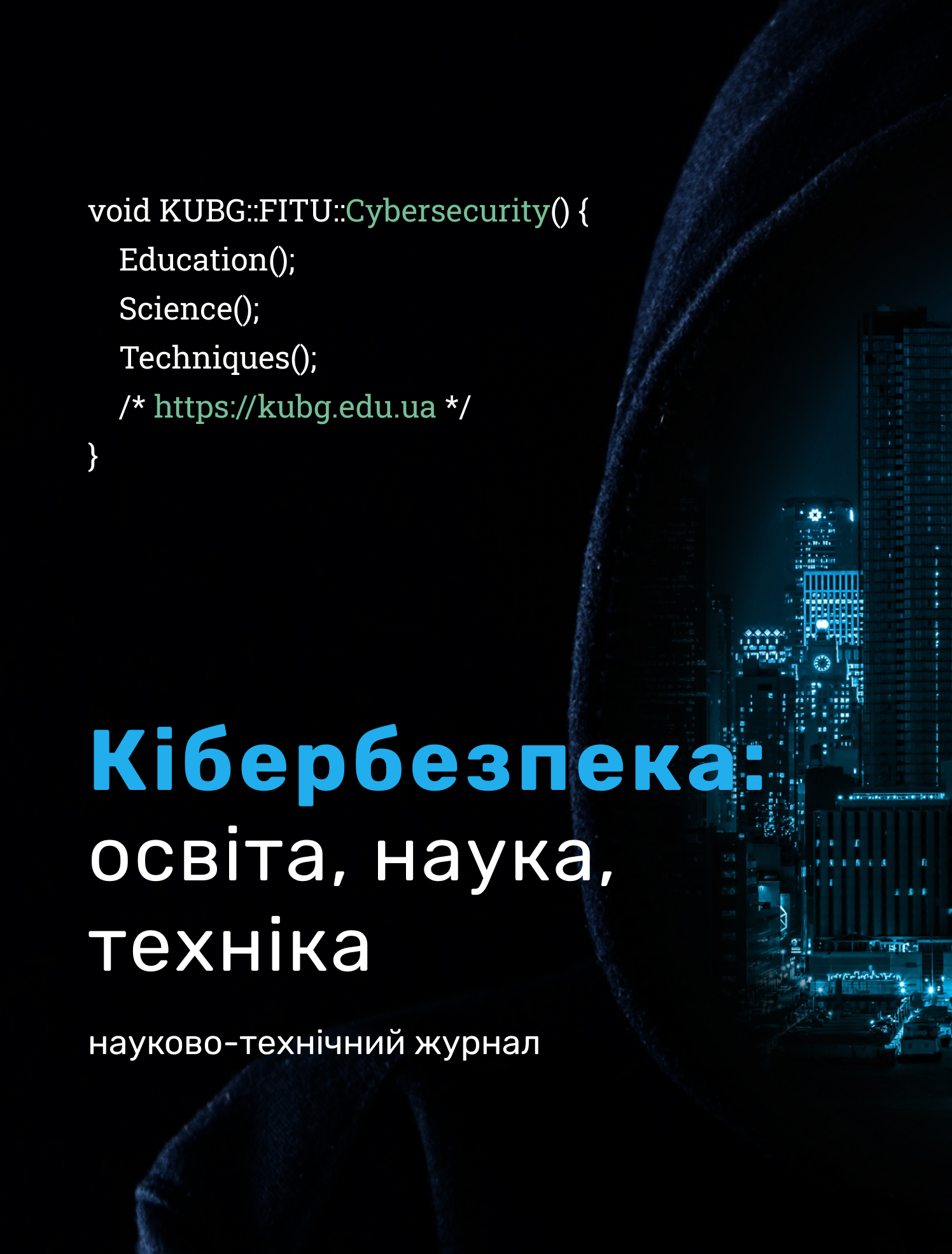МЕТОДОЛОГІЧНІ ЗАСАДИ АТРИБУЦІЇ СУБ’ЄКТІВ ГІБРИДНОЇ АГРЕСІЇ В НАЦІОНАЛЬНОМУ КІБЕРПРОСТОРІ
DOI:
https://doi.org/10.28925/2663-4023.2025.30.904Ключові слова:
атрибуція кібератак, гібридна війна, національна кібербезпека, інформаційно-психологічні операціїАнотація
В умовах триваючої гібридної агресії проти України, здатність точно ідентифікувати джерела ворожих дій у кіберпросторі є не просто технічним завданням, а критично важливим елементом національної безпеки. В даній статті запропоноване одне з вирішень наукової проблеми розробки комплексних методологічних засад для атрибуції суб’єктів гібридних загроз. У вступі акцентовано увагу на актуальність проблеми, що зумовлена необхідністю ефективної протидії скоординованим кібер- та інформаційно-психологічним операціям. Аналіз сучасних досліджень вітчизняних та закордонних науковців показує, що існуючі підходи до атрибуції часто є фрагментарними, зосереджуючись на технічних аспектах, контент-аналізі тощо, що створює нагальну потребу в єдиній, системній методології. Метою даної роботи є розробка цілісної методології атрибуції суб’єктів гібридної агресії, що дозволяє інтегрувати та синтезувати різнорідні дані для формування обґрунтованих висновків. Теоретичною базою дослідження стали концепції гібридної війни та сучасні підходи до аналізу великих даних. Методологія включає системний аналіз, діалектичний метод та моделювання, що дозволило структурувати складний, багатоетапний процес атрибуції. Ключовим науковим результатом є запропонована багаторівнева модель атрибуції, яка об’єднує аналіз на трьох рівнях: технічному (аналіз інфраструктури, шкідливого коду та інших цифрових артефактів), тактичному (ідентифікація стійких поведінкових дій, тактик, технік і процедур) та стратегічному (аналіз наративів, цілей та їх кореляції з геополітичними інтересами держави-агресора). Також у статті сформульовано систему критеріїв для верифікації та оцінки достовірності атрибутивних висновків. У висновках аргументовано, що запропонована модель дозволяє значно підвищити доказову цінність та обґрунтованість атрибуції, забезпечуючи глибоке розуміння стратегії супротивника. Перспективи подальших досліджень включають розробку прикладних аналітичних інструментів на базі штучного інтелекту та дослідження правових механізмів імплементації результатів дослідження.
Завантаження
Посилання
Natsionalna politsiia Ukrainy [National Police of Ukraine]. (n.d.). Ofitsiinyi sait Kiberpolitsii Ukrainy [Official site of the Cyberpolice of Ukraine]. Retrieved August 3, 2025, from https://cyberpolice.gov.ua/
Derzhavna sluzhba spetsialnoho zviazku ta zakhystu informatsii Ukrainy [State Service of Special Communications and Information Protection of Ukraine]. (n.d.). Ofitsiinyi sait [Official site]. Retrieved August 3, 2025, from https://cip.gov.ua/ua/news
Buriachenko, O. (2024). Hibrydna viina yak nova forma hlobalnoho protystoiannia [Hybrid warfare as a new form of global confrontation]. Naukovi pratsi Mizhrehionalnoi akademii upravlinnia personalom [Scientific works of the Interregional Academy of Personnel Management], (2), 24–31.
Zinchenko, O.I. (2025). Protydiia kiberteroryzmu yak zahrozi suchasnii natsionalnii bezpetsi derzhav Yevropeiskoho rehionu [Countering cyberterrorism as a threat to the modern national security of the states of the European region] [Doctoral dissertation, V. N. Karazin Kharkiv National University].
Verkhovtseva, I.H. (2024). Hlobalnyi kiberprostir ta opir informatsiinii ahresii: kiberdyplomatiia Ukrainy u protydii rosiiskii informatsiinii invazii [Global cyberspace and resistance to information aggression: Cyberdiplomacy of Ukraine in countering the Russian information invasion]. In Hlobalnyi kiberprostir: suchasni vyklyky ta rishennia [Global cyberspace: Modern challenges and solutions] (pp. 213–243). Baltija Publishing. http://www.baltijapublishing.lv/omp/index.php/bp/catalog/view/510/13505/28342-1
Rid, T. (2020). Active Measures: The Secret History of Disinformation and Political Warfare. Center for the Study of Intelligence. https://www.cia.gov/resources/csi/static/active-measures-and-information-wars.pdf
The NATO Cooperative Cyber Defence Centre of Excellence. (n.d.). The NATO Cooperative Cyber Defence Centre of Excellence. Retrieved August 23, 2025, from https://ccdcoe.org/
Lunhol, O.M. (2025). Synerhiia tsyfrovoi rozvidky ta alhorytmiv shtuchnoho intelektu dlia efektyvnoho vyiavlennia kiberzahroz [Synergy of digital intelligence and artificial intelligence algorithms for effective detection of cyber threats]. Nauka i tekhnika sohodni [Science and Technology Today], (2), 1320–1332.
Lunhol, O. (2024). Ohliad metodiv ta stratehii kiberbezpeky zasobamy shtuchnoho intelektu [Review of cybersecurity methods and strategies by means of artificial intelligence]. Elektronne fakhove naukove vydannia «Kiberbezpeka: osvita, nauka, tekhnika» [Electronic professional scientific publication "Cybersecurity: education, science, technology"], (1), 379–389.
Popov, G., & Orobets, K. (2025). Assessing War Crimes During Armed Conflicts: Insights from Ukraine and Global Standards. Journal of Lifestyle and SDGs Review, 5(1), e03391. https://doi.org/10.47172/2965-730X.SDGsReview.v5.n01.pe03391
Boiko, R. (2024). Tsyfrovi innovatsii v zapobihanni zlochynnosti ta profilaktytsi kryminalnykh pravoporushen [Digital innovations in crime prevention and prophylaxis of criminal offenses]. In Vzaiemodiia derzhavnykh orhaniv ta hromadskosti u sferi protydii kryminalnym pravoporushenniam u tsentralnykh rehionakh Ukrainy: zbirnyk materialiv kruhloho stolu [Interaction of state bodies and the public in the field of countering criminal offenses in the central regions of Ukraine: Collection of materials of the round table] (pp. 144–146). DonDUVS.
Shaiets, Ye., & Lunhol, O. (2022). Vykorystannia khanipotiv dlia vyiavlennia merezhevykh atak [The use of honeypots for detecting network attacks]. In Informatsiina bezpeka ta informatsiini tekhnolohii: zbirnyk tez dopovidei IV Mizhnarodnoi naukovo-praktychnoi konferentsii, IBIT 2022 [Information security and information technologies: Collection of abstracts of the IV International scientific and practical conference, ISIT 2022] (pp. 93–95). Rastr-7.
Опубліковано
Як цитувати
Номер
Розділ
Ліцензія
Авторське право (c) 2025 Ольга Лунгол

Ця робота ліцензується відповідно до Creative Commons Attribution-NonCommercial-ShareAlike 4.0 International License.




